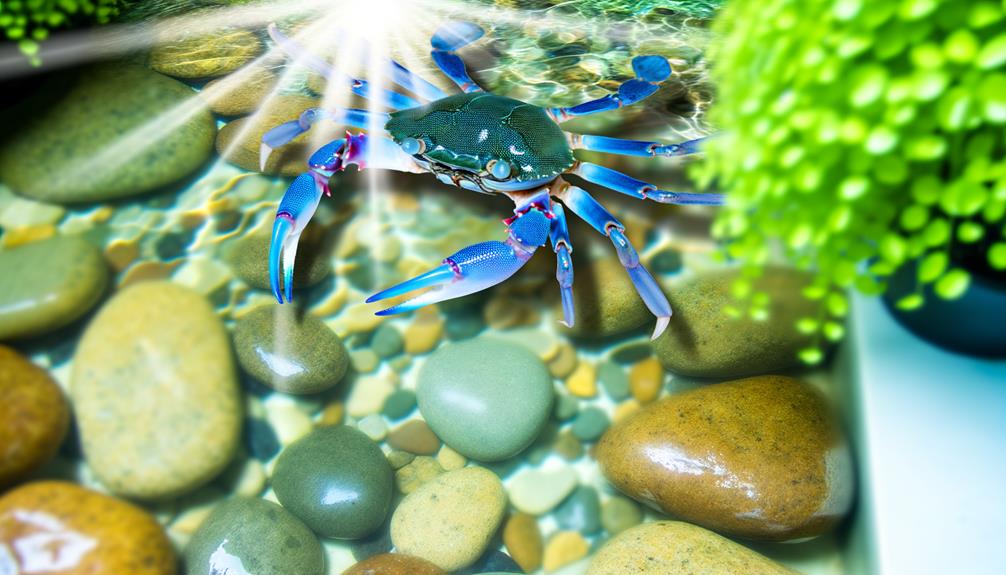Can Cats Eat Snow Crab?
Yes, blue crabs (Callinectes sapidus) can live in freshwater, but it's not their natural habitat. They normally thrive in brackish waters where salinity levels suit their physiological needs.
Freshwater presents osmoregulation challenges, disrupting their internal salt and water balance. Remarkably, some populations manage to adapt, showing accelerated growth rates in freshwater.
However, these adaptations can disrupt local ecosystems and food webs. The potential impacts on native species and biodiversity raise significant conservation concerns.
There's much more about their adaptability, ecological impact, and ongoing research to explore.

Key Takeaways
- Blue crabs face physiological stress in freshwater due to osmoregulation challenges.
- They can survive in freshwater but struggle to maintain internal salt and water balance.
- Blue crabs have shown some successful adaptation to freshwater in certain studies.
- Freshwater habitats may accelerate growth rates in juvenile blue crabs.
- Introducing blue crabs into freshwater poses risks of ecological disruption and conservation issues.
Blue Crab Biology

Blue crabs, scientifically known as Callinectes sapidus, are primarily found in brackish coastal waters, where they play an essential role in the ecosystem.
You've got a fascinating creature here, with their complex life cycle and adaptive physiology. These crabs possess a chitinous exoskeleton, which they periodically molt to grow. They've specialized gills that allow them to extract oxygen from the water, and their bodies are equipped with chelae (claws) for defense and foraging.
These omnivores feed on a diverse diet, including plants, smaller fish, and detritus, contributing significantly to nutrient cycling. Understanding their biology gives you insight into their adaptability and resilience, key factors in evaluating their potential to survive in varying environments, including freshwater.
Natural Habitats
You'll find blue crabs primarily in coastal ecosystems and estuarine environments, where they thrive in brackish waters. These habitats provide the best salinity levels necessary for their survival and reproduction.
Understanding their natural habitats is essential to assess their adaptability to freshwater conditions.
Coastal Ecosystems
Coastal ecosystems, often teeming with biodiversity, provide the essential brackish water habitats necessary for the survival of blue crabs. These ecosystems consist of complex intertidal zones where saltwater from the ocean mixes with freshwater from rivers.
You'll find that blue crabs thrive in these areas due to the ideal salinity levels, abundant food sources, and suitable breeding grounds. Mangroves, salt marshes, and seagrass beds play important roles in maintaining these habitats. They act as natural filters, trapping sediments and pollutants that would otherwise harm blue crabs.
Understanding the intricate dynamics of coastal ecosystems allows you to appreciate how these environments support not just blue crabs, but a myriad of species, ensuring ecological balance and biodiversity.
Estuarine Environments
Estuarine environments, where freshwater from rivers meets and mixes with seawater, create the brackish conditions that are essential for the life cycle of blue crabs. You'll find these habitats teeming with nutrients, supporting diverse flora and fauna.
Blue crabs thrive here due to the salinity gradient, which provides ideal conditions for their growth, molting, and reproduction. Juvenile blue crabs use these areas for protection and feeding, while adults migrate to higher salinity zones for breeding.
The estuarine environment's dynamic nature ensures a balance of oxygen levels, temperature, and food supply, critical for their survival. Understanding these ecosystems allows you to appreciate the complexities of blue crab habitats and the delicate balance they need to flourish.
Freshwater Challenges

Blue crabs face significant physiological stress when exposed to freshwater environments. Their bodies are adapted to brackish waters, where salinity levels fluctuate but remain within a tolerable range. In freshwater, they struggle to maintain osmoregulation, which is essential for their survival. Osmoregulation involves balancing salt and water levels within their tissues, a process that's disrupted without the saline component of their natural habitat.
Here's a quick comparison of the conditions:
| Environment | Salinity Level | Osmoregulation Impact |
|---|---|---|
| Estuarine | Moderate | Best |
| Brackish | Variable | Manageable |
| Freshwater | Low/None | High Stress |
Understanding these differences highlights why blue crabs can't thrive in freshwater, emphasizing the importance of their native estuarine and brackish environments.
Adaptation Mechanisms
To adapt to varying salinity levels, blue crabs employ specialized physiological mechanisms that allow them to regulate their internal salt and water balance.
You'll find that their gills play an essential role in osmoregulation, actively transporting ions to maintain equilibrium.
They possess chloride cells that help excrete excess salts when in high salinity and conserve salts in freshwater environments.
Blue crabs also adjust their urine production rates to manage water influx, ensuring cellular stability.
Additionally, their exoskeletons contribute by acting as a barrier to uncontrolled ion exchange.
These adaptations aren't immediate but develop over time, showcasing the blue crab's remarkable ability to thrive in diverse aquatic habitats, from saline waters to brackish environments and even freshwater.
Case Studies

You'll find that examining specific case studies provides valuable insights into blue crabs' ability to adapt to freshwater environments.
These examples highlight both successful adaptation strategies and the inherent challenges faced during freshwater survival.
Let's analyze these case studies to understand the factors influencing their viability in non-saline habitats.
Successful Adaptation Examples
Several notable case studies highlight the successful adaptation of blue crabs to freshwater environments, showcasing their remarkable physiological flexibility.
One study observed blue crabs thriving in the Patuxent River, Maryland, a mostly freshwater habitat. Researchers documented their ability to regulate osmotic pressure, essential for maintaining cellular function.
Another case in North Carolina's Albemarle Sound revealed that blue crabs could adapt by modifying their gill function, improving their ion transport efficiency.
Additionally, a Louisiana study showed that juvenile blue crabs exhibited accelerated growth rates when introduced to freshwater, suggesting they could optimize resource utilization.
These examples underscore the blue crab's adaptability, positioning them as a species capable of thriving in diverse environments, which appeals to your sense of exploration and freedom.
Freshwater Survival Challenges
Despite their adaptability, blue crabs face specific challenges when attempting to survive in freshwater environments. One major issue is osmoregulation. Blue crabs are naturally designed to thrive in saline conditions, so freshwater forces them to expend more energy regulating their internal salt concentrations.
Additionally, freshwater environments often lack the necessary calcium levels required for their exoskeleton development and molting processes. Studies have shown that blue crabs in freshwater exhibit slower growth rates and higher mortality. Predation also increases, as they can't use their typical saline habitats for refuge.
In case studies, crabs relocated to freshwater often fail to reproduce effectively, further threatening their population sustainability. These challenges underscore why blue crabs are rare in freshwater ecosystems.
Experimental Findings
Researchers conducted controlled experiments to assess the adaptability of blue crabs to freshwater environments. You'll find these studies rigorously tested variables like salinity, temperature, and pH levels. Scientists placed blue crabs in freshwater tanks while closely monitoring their physiological responses.
They measured survival rates, molting cycles, and feeding behaviors to gather thorough data. Results indicated some blue crabs tolerated low salinity levels for short periods but showed signs of stress and reduced survival over extended durations. Key indicators such as hemolymph osmolality and gill functionality were significantly impacted.
You can conclude that while blue crabs exhibit some short-term adaptability, their long-term viability in freshwater is questionable. These specific findings provide valuable insights into their ecological limits and potential applications.
Potential Ecological Impact

Understanding the blue crabs' limited adaptability to freshwater environments prompts an examination of the potential ecological impact on both the species and their surrounding ecosystems.
First, introducing blue crabs into freshwater habitats may disrupt local food webs, potentially leading to:
- Predation Imbalance: Blue crabs could prey on native species, reducing biodiversity.
- Resource Competition: They may compete with native species for food and habitat, altering population dynamics.
- Disease Transmission: Blue crabs might introduce new pathogens to freshwater environments, affecting native fauna.
Conservation Concerns
Frequently, introducing blue crabs into freshwater habitats raises significant conservation concerns that warrant careful examination.
You must consider the potential for blue crabs to disrupt local ecosystems by outcompeting native species for resources such as food and habitat.
Additionally, blue crabs may introduce new pathogens or parasites that could negatively impact indigenous aquatic life.
The alteration of these ecosystems can lead to a decline in biodiversity, upsetting the natural balance and causing long-term environmental damage.
You should also account for the potential economic impact on fisheries that rely on native species.
It's essential to evaluate these factors meticulously to make sure that any actions taken don't compromise the health and sustainability of freshwater ecosystems.
Future Research

Given the potential ecological and economic impacts of introducing blue crabs into freshwater habitats, future research should prioritize understanding their adaptability and interactions within these environments.
You should focus on several key areas to ensure a thorough approach:
- Physiological Adaptations: Investigate how blue crabs adjust their osmoregulatory mechanisms to cope with freshwater conditions.
- Ecological Interactions: Examine the impact of blue crabs on native species and freshwater ecosystems, including potential competition and predation dynamics.
- Economic Implications: Assess the potential benefits and costs associated with freshwater blue crab fisheries, considering both market opportunities and management challenges.
Conclusion
Just like a seasoned sailor exploring uncharted waters, blue crabs face significant challenges when venturing into freshwater environments.
A notable study revealed that only 25% of blue crabs survived more than a week in freshwater conditions. This underscores their inherent need for saline habitats.
Your understanding of these intricate dynamics can guide conservation efforts, ensuring these remarkable creatures thrive where they belong.
Embrace the complexity, much like the blue crab adapts to its ever-changing tides.






